英汉文化差异
- 格式:doc
- 大小:155.00 KB
- 文档页数:33
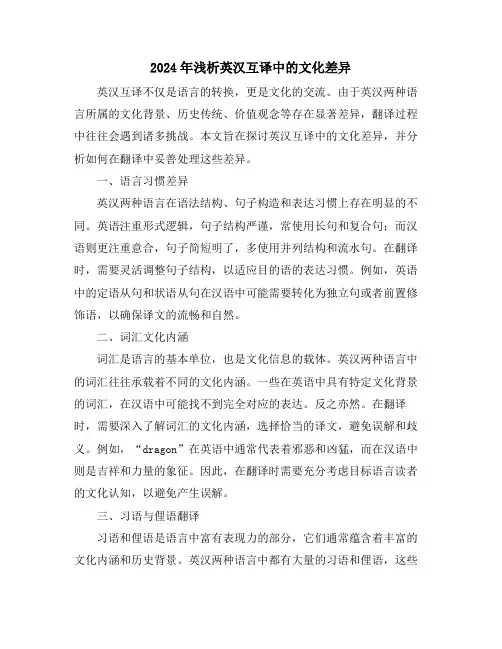
2024年浅析英汉互译中的文化差异英汉互译不仅是语言的转换,更是文化的交流。
由于英汉两种语言所属的文化背景、历史传统、价值观念等存在显著差异,翻译过程中往往会遇到诸多挑战。
本文旨在探讨英汉互译中的文化差异,并分析如何在翻译中妥善处理这些差异。
一、语言习惯差异英汉两种语言在语法结构、句子构造和表达习惯上存在明显的不同。
英语注重形式逻辑,句子结构严谨,常使用长句和复合句;而汉语则更注重意合,句子简短明了,多使用并列结构和流水句。
在翻译时,需要灵活调整句子结构,以适应目的语的表达习惯。
例如,英语中的定语从句和状语从句在汉语中可能需要转化为独立句或者前置修饰语,以确保译文的流畅和自然。
二、词汇文化内涵词汇是语言的基本单位,也是文化信息的载体。
英汉两种语言中的词汇往往承载着不同的文化内涵。
一些在英语中具有特定文化背景的词汇,在汉语中可能找不到完全对应的表达。
反之亦然。
在翻译时,需要深入了解词汇的文化内涵,选择恰当的译文,避免误解和歧义。
例如,“dragon”在英语中通常代表着邪恶和凶猛,而在汉语中则是吉祥和力量的象征。
因此,在翻译时需要充分考虑目标语言读者的文化认知,以避免产生误解。
三、习语与俚语翻译习语和俚语是语言中富有表现力的部分,它们通常蕴含着丰富的文化内涵和历史背景。
英汉两种语言中都有大量的习语和俚语,这些表达在直译时往往难以传达原文的含义。
因此,在翻译时需要对习语和俚语进行深入的研究和理解,找出它们在不同文化中的对应表达或者采用意译的方式传达原文的语义和情感色彩。
同时,还需要注意保持原文的风格和韵律美感,以使译文更具吸引力和感染力。
四、思维方式的差异英汉两种语言使用者的思维方式也存在差异。
英语国家的人们往往更注重逻辑分析和形式推理,而汉语国家的人们则更注重整体思维和直观感悟。
这种差异在翻译中表现为对同一事物的描述和表达方式的不同。
因此,在翻译时需要充分考虑目标语言读者的思维习惯,适当调整表达方式,以使译文更符合目标语言读者的阅读习惯和审美需求。
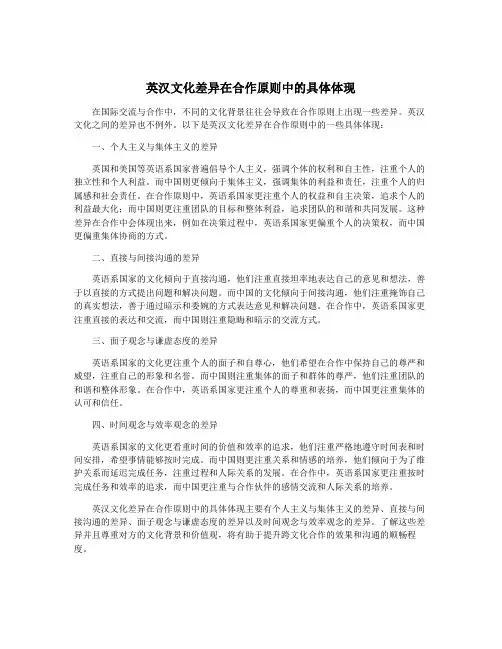
英汉文化差异在合作原则中的具体体现在国际交流与合作中,不同的文化背景往往会导致在合作原则上出现一些差异。
英汉文化之间的差异也不例外。
以下是英汉文化差异在合作原则中的一些具体体现:一、个人主义与集体主义的差异英国和美国等英语系国家普遍倡导个人主义,强调个体的权利和自主性,注重个人的独立性和个人利益。
而中国则更倾向于集体主义,强调集体的利益和责任,注重个人的归属感和社会责任。
在合作原则中,英语系国家更注重个人的权益和自主决策,追求个人的利益最大化;而中国则更注重团队的目标和整体利益,追求团队的和谐和共同发展。
这种差异在合作中会体现出来,例如在决策过程中,英语系国家更偏重个人的决策权,而中国更偏重集体协商的方式。
二、直接与间接沟通的差异英语系国家的文化倾向于直接沟通,他们注重直接坦率地表达自己的意见和想法,善于以直接的方式提出问题和解决问题。
而中国的文化倾向于间接沟通,他们注重掩饰自己的真实想法,善于通过暗示和委婉的方式表达意见和解决问题。
在合作中,英语系国家更注重直接的表达和交流,而中国则注重隐晦和暗示的交流方式。
三、面子观念与谦虚态度的差异英语系国家的文化更注重个人的面子和自尊心,他们希望在合作中保持自己的尊严和威望,注重自己的形象和名誉。
而中国则注重集体的面子和群体的尊严,他们注重团队的和谐和整体形象。
在合作中,英语系国家更注重个人的尊重和表扬,而中国更注重集体的认可和信任。
四、时间观念与效率观念的差异英语系国家的文化更看重时间的价值和效率的追求,他们注重严格地遵守时间表和时间安排,希望事情能够按时完成。
而中国则更注重关系和情感的培养,他们倾向于为了维护关系而延迟完成任务,注重过程和人际关系的发展。
在合作中,英语系国家更注重按时完成任务和效率的追求,而中国更注重与合作伙伴的感情交流和人际关系的培养。
英汉文化差异在合作原则中的具体体现主要有个人主义与集体主义的差异、直接与间接沟通的差异、面子观念与谦虚态度的差异以及时间观念与效率观念的差异。
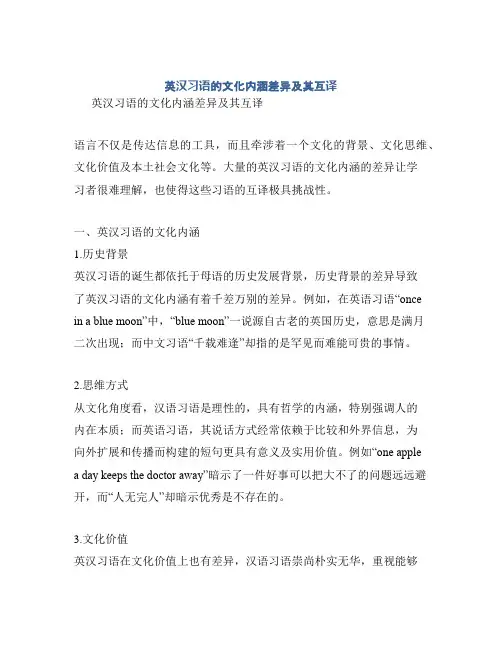
英汉习语的文化内涵差异及其互译英汉习语的文化内涵差异及其互译语言不仅是传达信息的工具,而且牵涉着一个文化的背景、文化思维、文化价值及本土社会文化等。
大量的英汉习语的文化内涵的差异让学习者很难理解,也使得这些习语的互译极具挑战性。
一、英汉习语的文化内涵1.历史背景英汉习语的诞生都依托于母语的历史发展背景,历史背景的差异导致了英汉习语的文化内涵有着千差万别的差异。
例如,在英语习语“oncein a blue moon”中,“blue moon”一说源自古老的英国历史,意思是满月二次出现;而中文习语“千载难逢”却指的是罕见而难能可贵的事情。
2.思维方式从文化角度看,汉语习语是理性的,具有哲学的内涵,特别强调人的内在本质;而英语习语,其说话方式经常依赖于比较和外界信息,为向外扩展和传播而构建的短句更具有意义及实用价值。
例如“one applea day keeps the doctor away”暗示了一件好事可以把大不了的问题远远避开,而“人无完人”却暗示优秀是不存在的。
3.文化价值英汉习语在文化价值上也有差异,汉语习语崇尚朴实无华,重视能够磨练心智的思考和行为;而英语习语则崇尚高尚的文明,强调坚持原则,如“no pain no gain(不努力没有收获)”。
二、英汉习语的互译由于英汉习语的文化内涵差异,仅通过翻译不能完全表达原有的内涵和意义,这就导致英汉习语的互译很容易出现问题。
1.词义辨析单纯以词义辨析为准,很容易翻译错误。
例如,英语中的“apple”既指苹果又指英国的“苹果公司”,而中文中的“苹果”则只指吃的水果,并不能翻译成“Apple”。
2.文化差异由于文化差异,原有的文化背景意义很容易丢失,也影响了英汉习语的可操作性。
例如,英语中的“red tape”指的是政府官僚作风,表现在中文中就变成了“繁文缛节”;另外,英语习语“pig in a poke”源自旧时西洋猪拳,中文则变成“买老虎铁笼”,并多带着贬义。

英汉的文化差异及翻译外国文学最难了解和翻译的第一是联想的意义,接下来,小编给大家准备了英汉的文化差异及翻译,欢迎大家参考与借鉴。
英汉的文化差异及翻译一、英汉习语中所反映的文化差异朱光潜先生在《谈翻译》一文中说:"外国文学最难了解和翻译的第一是联想的意义……","它带有特殊的情感氛围,甚深广而微妙,在字典中无从找出,对文学却极要紧。
如果我们不熟悉一国的人情风俗和文化历史背景,对于文字的这种意义就茫然,尤其是在翻译时这种字义最不易应付。
"英国文化人类学家爱德华·泰勒在《原始文化》(1871)一书中,首次把文化作为一个概念提了出来,并表述为:"文化是一种复杂,它包括知识、信仰、艺术、道德、法律、风俗以及其作社会上习得的能力与习惯。
"可见文化的覆盖面很广,它是一个复要的系统。
语言作为文化的一个组成部分,反映一个民族丰富多彩的方化现象。
1、生存环境的差异习语的产生与人们的劳动和生活密切相关。
英国是一个岛国,历史上航海业曾一度领先世界;而汉民族在亚洲大陆生活繁衍,人们的生活离不开土地。
比喻花钱浪费,大手大脚,英语是spend money like water,而汉语是"挥金如土"。
英语中有许多关于船和水的习语,在汉语中没有完全相同的对应习语,如to rest on one's oars(暂时歇一歇),to keep one's head above water(奋力图存),all at sea(不知所措)等等。
在汉语的文化氛围中,"东风"即是"春天的风",夏天常与酷署炎热联系在一起,"赤日炎炎似火烧"、"骄阳似火"是常被用来描述夏天的词语。
而英国地处西半球,北温带,海洋性气候,报告春天消息的却是西风,英国著名诗人雪莱的《西风颂》正是对春的讴歌。

关于英汉习语的文化差异分析与翻译探讨随着全球化的加速发展,语言交流在我们的生活中变得越来越重要。
而习语是一种充满文化色彩的语言形式,它不仅仅是语言交流的一种方式,更是反映文化差异的重要表现形式。
在进行英汉翻译时,习语翻译是一个重要的挑战。
本文将对英汉习语的文化差异及翻译进行分析与探讨。
一、文化差异文化是一种社会共同体中的共同思考方式。
在不同的文化中,习语具有不同的含义和使用方式。
因此,了解文化差异是进行习语翻译时必须考虑的重要因素。
1. 天气习语2. 社交习语英语中的社交习语非常多,如“How do you do?”(你好吗?),“Nice to meet you”(见到你很高兴)等。
这些习语是英语中非常常见的礼仪用语,但在中国,这些习语的使用频率比较少,中国人普遍更多地使用谦虚、客气的表达方式,如“麻烦您了”、“不好意思”等。
3. 食品习语英语中也有很多与食品有关的习语,如“the icing on the cake”(锦上添花)、“to have a sweet tooth”(爱吃甜的)等。
这些习语反映出英国人对食品非常重视,而且很多情况下会使用食品作为比喻。
而在中国,食品的比喻习语也不少,如“一餐打发”、“一碗水端平”等,但与英语不同的是,这些习语中的食品往往是具体的中式菜肴,比如面条、米饭等。
二、翻译探讨在进行英汉习语翻译时,需要遵循一些原则,以保持习语意义的完整性和准确性。
1. 动态等效原则在进行英汉习语翻译时,应遵循动态等效原则,即尽量使目标语习语翻译后的结果与源语习语意义相同或相似。
因为习语具有文化差异性,所以在进行习语翻译时,要结合文化差异,考虑目标语读者的文化背景和习惯,确定习语的翻译技巧和策略。
2. 语境翻译原则在进行英汉习语翻译时,要注意语境的含义和使用。
习语通常都是在特定的语境中形成的,所以在进行翻译时要尽量使翻译后的结果与源语习语在语境上相似。
3. 保留原汁原味的原则在进行英汉习语翻译时,要尽量保留习语的原味,即保持原习语的形式和含义。
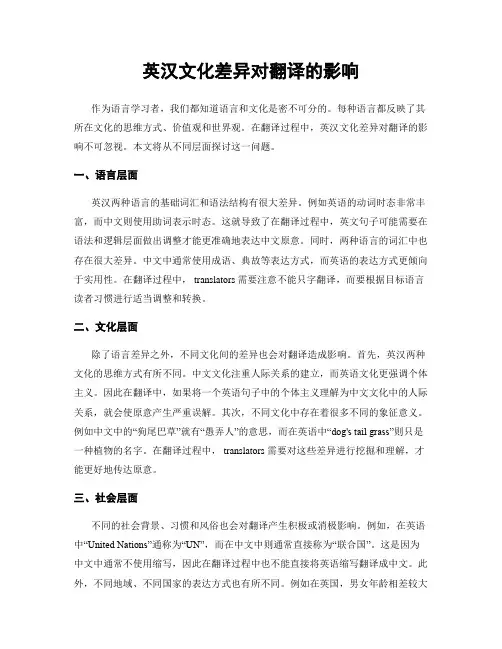
英汉文化差异对翻译的影响作为语言学习者,我们都知道语言和文化是密不可分的。
每种语言都反映了其所在文化的思维方式、价值观和世界观。
在翻译过程中,英汉文化差异对翻译的影响不可忽视。
本文将从不同层面探讨这一问题。
一、语言层面英汉两种语言的基础词汇和语法结构有很大差异。
例如英语的动词时态非常丰富,而中文则使用助词表示时态。
这就导致了在翻译过程中,英文句子可能需要在语法和逻辑层面做出调整才能更准确地表达中文原意。
同时,两种语言的词汇中也存在很大差异。
中文中通常使用成语、典故等表达方式,而英语的表达方式更倾向于实用性。
在翻译过程中, translators 需要注意不能只字翻译,而要根据目标语言读者习惯进行适当调整和转换。
二、文化层面除了语言差异之外,不同文化间的差异也会对翻译造成影响。
首先,英汉两种文化的思维方式有所不同。
中文文化注重人际关系的建立,而英语文化更强调个体主义。
因此在翻译中,如果将一个英语句子中的个体主义理解为中文文化中的人际关系,就会使原意产生严重误解。
其次,不同文化中存在着很多不同的象征意义。
例如中文中的“狗尾巴草”就有“愚弄人”的意思,而在英语中“dog's tail grass”则只是一种植物的名字。
在翻译过程中, translators 需要对这些差异进行挖掘和理解,才能更好地传达原意。
三、社会层面不同的社会背景、习惯和风俗也会对翻译产生积极或消极影响。
例如,在英语中“United Nations”通称为“UN”,而在中文中则通常直接称为“联合国”。
这是因为中文中通常不使用缩写,因此在翻译过程中也不能直接将英语缩写翻译成中文。
此外,不同地域、不同国家的表达方式也有所不同。
例如在英国,男女年龄相差较大的情侣被称为“couple”,而在中国这种情况通常被称为“老少配”。
在翻译过程中,translators 需要对这些区别进行注意和把握。
结论总的来说,英汉文化差异对翻译的影响不可避免。
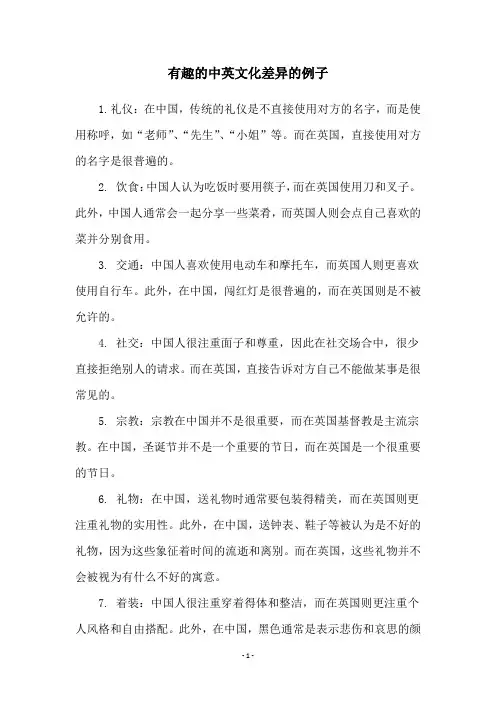
有趣的中英文化差异的例子
1.礼仪:在中国,传统的礼仪是不直接使用对方的名字,而是使用称呼,如“老师”、“先生”、“小姐”等。
而在英国,直接使用对方的名字是很普遍的。
2. 饮食:中国人认为吃饭时要用筷子,而在英国使用刀和叉子。
此外,中国人通常会一起分享一些菜肴,而英国人则会点自己喜欢的菜并分别食用。
3. 交通:中国人喜欢使用电动车和摩托车,而英国人则更喜欢使用自行车。
此外,在中国,闯红灯是很普遍的,而在英国则是不被允许的。
4. 社交:中国人很注重面子和尊重,因此在社交场合中,很少直接拒绝别人的请求。
而在英国,直接告诉对方自己不能做某事是很常见的。
5. 宗教:宗教在中国并不是很重要,而在英国基督教是主流宗教。
在中国,圣诞节并不是一个重要的节日,而在英国是一个很重要的节日。
6. 礼物:在中国,送礼物时通常要包装得精美,而在英国则更注重礼物的实用性。
此外,在中国,送钟表、鞋子等被认为是不好的礼物,因为这些象征着时间的流逝和离别。
而在英国,这些礼物并不会被视为有什么不好的寓意。
7. 着装:中国人很注重穿着得体和整洁,而在英国则更注重个人风格和自由搭配。
此外,在中国,黑色通常是表示悲伤和哀思的颜
色,而在英国则通常是正式场合的常用颜色。
8. 教育:在中国,家长通常会很严格地督促孩子的学习,而在英国则更注重培养孩子的独立思考和创造能力。
此外,英国的小学、中学和大学之间的教育体系也有很大的差异。
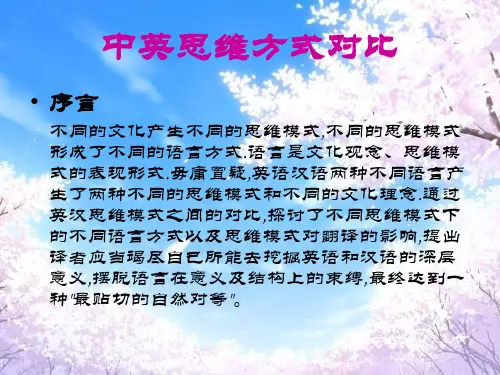
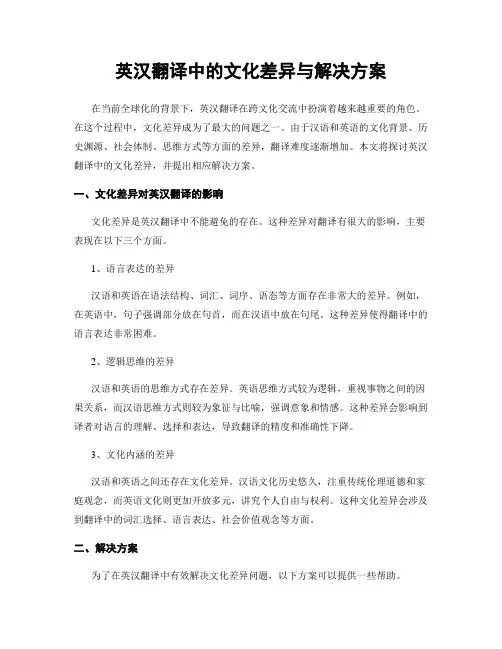
英汉翻译中的文化差异与解决方案在当前全球化的背景下,英汉翻译在跨文化交流中扮演着越来越重要的角色。
在这个过程中,文化差异成为了最大的问题之一。
由于汉语和英语的文化背景、历史渊源、社会体制、思维方式等方面的差异,翻译难度逐渐增加。
本文将探讨英汉翻译中的文化差异,并提出相应解决方案。
一、文化差异对英汉翻译的影响文化差异是英汉翻译中不能避免的存在。
这种差异对翻译有很大的影响,主要表现在以下三个方面。
1、语言表达的差异汉语和英语在语法结构、词汇、词序、语态等方面存在非常大的差异。
例如,在英语中,句子强调部分放在句首,而在汉语中放在句尾。
这种差异使得翻译中的语言表达非常困难。
2、逻辑思维的差异汉语和英语的思维方式存在差异。
英语思维方式较为逻辑,重视事物之间的因果关系,而汉语思维方式则较为象征与比喻,强调意象和情感。
这种差异会影响到译者对语言的理解、选择和表达,导致翻译的精度和准确性下降。
3、文化内涵的差异汉语和英语之间还存在文化差异。
汉语文化历史悠久,注重传统伦理道德和家庭观念,而英语文化则更加开放多元,讲究个人自由与权利。
这种文化差异会涉及到翻译中的词汇选择、语言表达、社会价值观念等方面。
二、解决方案为了在英汉翻译中有效解决文化差异问题,以下方案可以提供一些帮助。
1、读懂原文在英汉翻译中,译者必须先理解原文的文化特点和背景知识。
只有读懂原文,才能有效地翻译出高质量的译文。
2、适度的文化调整在翻译时,译者应根据目标语言的受众和文化内涵适度地对原文进行调整。
例如,将饮食和节日的翻译调整为与受众文化相符的词汇和表述方式,从而使其更容易为读者所接受和理解。
3、避免直译直译是指将原文的词汇、语法结构和语言风格等直接转换成目标语言的方式。
在翻译中,直译往往会导致译文的意思不准确或者表达方式拗口,因此应该尽量避免直译的方法。
4、加大文化学习与交流英汉翻译中文化差异的问题需要通过增加语言学习与文化交流来进行解决。
翻译者需要加强对源语言和目标语言的学习,了解不同文化之间的异同,从而提升翻译质量和跨文化交流能力。
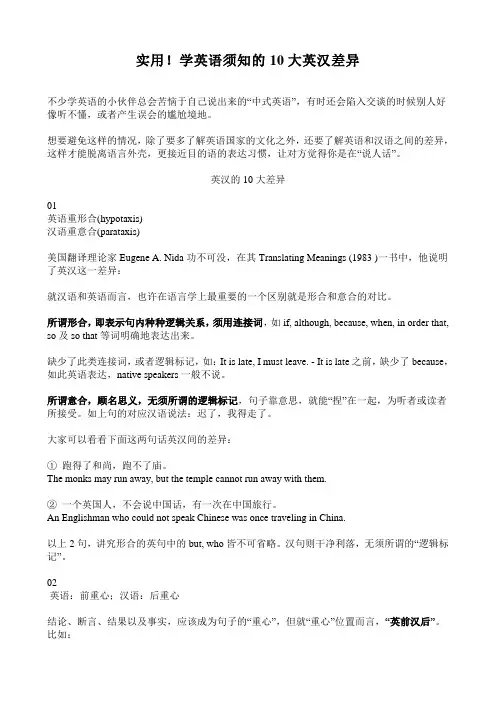
实用!学英语须知的10大英汉差异不少学英语的小伙伴总会苦恼于自己说出来的“中式英语”,有时还会陷入交谈的时候别人好像听不懂,或者产生误会的尴尬境地。
想要避免这样的情况,除了要多了解英语国家的文化之外,还要了解英语和汉语之间的差异,这样才能脱离语言外壳,更接近目的语的表达习惯,让对方觉得你是在“说人话”。
英汉的10大差异01英语重形合(hypotaxis)汉语重意合(parataxis)美国翻译理论家Eugene A. Nida功不可没,在其Translating Meanings (1983 )一书中,他说明了英汉这一差异:就汉语和英语而言,也许在语言学上最重要的一个区别就是形合和意合的对比。
所谓形合,即表示句内种种逻辑关系,须用连接词,如if, although, because, when, in order that, so及so that等词明确地表达出来。
缺少了此类连接词,或者逻辑标记,如:It is late, I must leave. - It is late之前,缺少了because,如此英语表达,native speakers一般不说。
所谓意合,顾名思义,无须所谓的逻辑标记,句子靠意思,就能“捏”在一起,为听者或读者所接受。
如上句的对应汉语说法:迟了,我得走了。
大家可以看看下面这两句话英汉间的差异:①跑得了和尚,跑不了庙。
The monks may run away, but the temple cannot run away with them.②一个英国人,不会说中国话,有一次在中国旅行。
An Englishman who could not speak Chinese was once traveling in China.以上2句,讲究形合的英句中的but, who皆不可省略。
汉句则干净利落,无须所谓的“逻辑标记”。
02英语:前重心;汉语:后重心结论、断言、结果以及事实,应该成为句子的“重心”,但就“重心”位置而言,“英前汉后”。
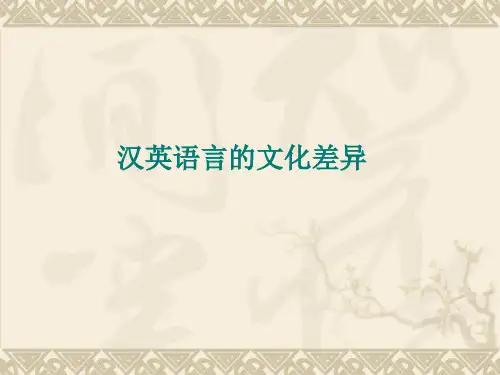
英汉语言十大差异中英文不同于是一个比较常见的话题,两种语言之间的差异不仅体现在词汇、语法、句式、口音等方面,还有很多其他的微小的变化。
以下是英汉语言的十大差异。
一、语序不同中文有固定的主谓宾语的语序,而英文却可以根据需要变换其语序。
例如:•中文:我吃苹果。
•英文:I eat an apple. 或 An apple I eat.在英文中,形容词通常放在名词前面,而在中文中则是后面。
二、冠词英文有定冠词(the)和不定冠词(a/an),而中文则没有冠词。
例如:•英文:The cat is playing with a ball.•中文:猫正在玩球。
三、动词变化英文的动词变化比较复杂,包括时态、语态、人称等方面的变化。
而中文的动词则没有这么多的变化。
例如:•英文:I am eating.•中文:我正在吃。
四、数词英文的数词有单复数之分,而中文则没有。
例如:•英文:There are five cats.•中文:有五只猫。
五、名词性格英文的名词有可数和不可数之分,而中文的名词则没有这种区别。
例如:•英文:There is some water in the glass.•中文:杯子里有些水。
六、代词英文的代词种类较多,包括主、宾、物主等。
而中文的代词比较简单。
例如:•英文:He gave me his book.•中文:他把他的书给了我。
七、词汇用法两种语言的词汇用法也有所不同。
例如:•英文:He is interested in music.•中文:他对音乐很感兴趣。
八、语气两种语言的语气表达方式也有一些差异。
例如:•英文:Could you help me, please?•中文:请你能帮助我吗?九、拟声词中文的拟声词较多,而英文则相对较少。
例如:•中文:咕咚(水声)•英文:drip(滴水声)十、表达感情中文在表达感情时比较直白,而英文则更为委婉。
例如:•中文:我爱你。
•英文:I love you. 或者 I adore you.总的来说,中英文之间有很多差异,这些差异反映了不同文化的不同特点。
从语言学角度对比中英语言文化差异中英语言文化差异是指中文和英文在语言结构、词汇使用、语言习惯等方面存在的差异。
从语言学的角度来看,中英语言文化差异主要体现在以下几个方面:一、语音音素和语音规则的差异中文和英文在语音音素上存在一定差异。
中文中,音节的音质较为简单,音节中的声母和韵母构成了音节的基本重要部分。
而英文中,辅音相对较多,辅音和元音的组合形式也较为复杂。
英文的元音数量较多,元音的发音也比中文更加多变。
二、词汇差异中英语言的词汇有很大的差异。
中文的词汇较为丰富,很多个词汇可以有多种不同的意思,一个字可以表示一个意义,也可以结合其他字形成词组,具有很高的词汇灵活性。
而英文的词汇相对较为简单,虽然英语也有同音或近音的词汇,但在一般情况下,同一个词只有一个特定的意义。
三、句法和语法差异中文和英文在句法和语法上也存在差异。
中文属于屈折语言,名词和形容词没有单/复数、性别、格的变化,这使得中文的句子结构相对简单。
而英文则属于有形态变化的屈折语言,名词和形容词的单/复数、性别、格等变化较多,使得英文的句子结构相对复杂。
四、文化差异中英语言的文化背景也造成了一定的差异。
中文表达更偏重于内涵,强调文化内涵的分享和传递,注重语言的修辞手法,而英文表达更注重事实表述,偏向于简洁和直接。
因为中英两个文化的差异,导致中英语言的使用中也会出现一些行为规范的差异,例如语气的使用、尊称的使用等。
中英语言文化差异在语音音素、词汇、句法和语法等方面都存在一定的差异。
这一差异主要源于两个语言的历史文化差异以及语言的不同特点。
了解和体会这些差异有助于更好地掌握和运用两种语言,促进中英两种文化之间的交流与理解。
英汉习语的文化差异及其翻译中文摘要同一句话,不同的文化背景的人反应有时是不同的,甚至会截然相反。
究其原因是说话双方没有真正了解对方的文化。
因此,完全有必要对中西文化差异进行研究。
习语是各国文化的精髓,反映各国的风俗习惯。
它作为语言的精华承载着丰富的文化信息,充分反映出英汉两种语言的文化差异。
因此,本文从最能体现中西文化差异的习语着手,论述习语在文化上六个方面中所反映的中西文化差异,即生存环境、生活习俗、宗教信仰、历史典故、对客观事物的认识、数字习语的差异。
从总体上看,英汉习语在表现语义和文化特征方面,主要有三种类型,即对应关系、半对应关系和不对应关系。
在翻译时,对应关系的习语可采用直译的方法。
半对应关系和不对应关系的习语应该首先弄清它们的文化内涵和实际意义,再根据上下文的意思灵活处理。
因此,英汉习语的翻译不应只是两种语言的简单转换,更应是文化的交流。
掌握习语的翻译,对于培养语言的领悟力和跨文化的交际能力是十分必要的。
关键词:习语;文化差异;翻译AbstractDifferent people from different cultures may have different understandings of the same sentence because they are ignorant of target cultures. It is necessary for us to study the cultural differences in some fields between China and Western countries. Idioms, which reflect customs, are the essence of culture in every country. Idiomatic phrases, the essence of languages, are loaded with rich cultural information and serve as a mirror of cultural differences between Chinese and English. Therefore, in this paper, the author will discuss the idioms reflecting the differences of Chinese and English in six levels: living environment, custom, religion, allusion, the acknowledge of objective thing. When expressing linguistic meanings and cultural features, there are mainly three types of idioms: correspondent, semi-correspondent and non-correspondent. For the correspondent idioms, we can translate them word for word into the target language .But for the semi-correspondent and non-correspondent idioms, it’s better to make sure first of their cultural connotat ions and practical meanings, and then translate them appropriately according to the context. Therefore, translation of idiomatic phrases is more cultural communication than simple translation of these two languages. The mastery of the technique for translating idiomatic phrases is a must to the cultivation of linguistic comprehension and intercultural competence.Key words: idioms; cultural differences; translation语言承载着丰富的文化内涵,而作为语言精华的习语更是如此。
浅谈中英交际中的文化差异中英交际的文化差异主要体现在语言、礼仪、思维、价值观等方面。
这些差异对于跨国交流和合作尤其重要,因为文化差异经常导致误解和互相不理解。
以下是几个比较显著的例子:一、语言差异语言是文化的载体之一,中英语言所用的语音、词汇和语法体系差异甚大,有时以至于会产生令人难以想象的误解。
例如,“面子”、“吃亏”、“讨价还价”等中文习惯用语在英语中没有直接的对应词,英语中的“face”和“lose face”也远没有中文“面子”这个词那么丰富和复杂的文化内涵。
英语中的口吃现象(stammer)在中国人的思维中常常被理解成“傻”,而实际上这只是一种语音障碍。
二、礼仪差异中英交际的礼仪差异也很明显。
在中国传统文化中,讲究的是恭敬和尊敬,例如在面对长辈或上司的时候,一般会拜候并行礼以示尊重。
但在英国人看来,过于谨敬会显得过分,可能会被认为是不自然和虚伪。
相反,英国人习惯于在面对陌生人时保持一定的距离和独立,这在中国人看来可能显得冷淡和不友善。
三、思维差异中英交际中的思维方式也存在差异。
西方文化强调个人的独立性和自主性,强调个人价值,而中国传统文化则强调集体的利益和稳定,更注重人际关系。
这些价值观的差异可能导致文化冲突和误解。
例如,一个英语母语者可能在和他的中国同事交流时,会觉得这位同事太不主动、不坦率和不直白,而中国同事也可能觉得英国同事太粗鲁、太鲁莽、太无礼。
四、价值观差异中英文化最大的差异之一就是价值观的差异。
在中文文化中,婚姻家庭的重要性往往超越了个人的选择和幸福,而在英国的文化审美中,个人的幸福和选择更为重要。
具体体现在婚姻上的差异是,中国有“老来伴,少言妻”的传统,即年老之人可以有伴而年轻之人则可以由父母安排相亲,而在英国则强调自由恋爱和重视异性的私人空间。
这种价值观的差异可能导致中英交往中的误解和矛盾,比如父母安排的相亲对于英国人来说可能是一件令人不适的事情,而过早的结婚对于中国人来说可能是一件必须的事情。
在开放的现代社会,跨文化的言语交际显得愈发重要,已经成为现代交际中引人注目的一个特点。
交际中的文化差异随处可见,言语环境中的文化因素受到普遍重视。
下面是英汉文化中十大常见差异。
1、答复提问中国人对别人的问话,总是以肯定或者否认对方的话来确定用" 对〞或者"不对〞。
如:"我想你不到20 岁,对吗?〞"是的,我不到20 岁。
〞〔"不,我已经30 岁了。
〞〕英语中,对别人的问话,总是依据事实结果的肯定或者否认用"Yes〞或者"No〞。
如:"You're not a student, are you"""Yes,I am. "("No, I am not. ")2、亲属称谓英语的亲属以家庭为中心,一代人为一个称谓板块,只区别男性、女性,却无视配偶双方因性别不同而浮现的称谓差异。
显得男女平等。
如:英文"grandparents, grandfather ,grandmother〞,而中文"祖辈、爷爷、奶奶、外公、外婆〞。
再如,父母同辈中的称谓:英文"uncle〞和"aunt〞,而中文"伯伯、叔叔、舅舅等,姑妈、姨妈等〞。
还有,英文中的表示下辈的"nephew 和niece〞是不分侄甥的,表示同辈的"cousin〞不分堂表、性别。
3、考虑问题的主体中国人喜欢以对方为中心,考虑对方的情感。
比方:你想买什么?您想借什么书?而英语中,往往从自身的角度出发。
如:Can I help you"What can I do for you"4、问候用语中国人打招呼,普通都以对方处境或者动向为思量方向。
您去哪里?您是上班还是下班?而西方人往往认为这些纯属个人私事,不能随便问。
所以他们见面打招呼总是说:Hi/Hello!Good morning/afternoon/evening/night!How are you"It's a lovely day, isn't it"5、面对恭惟中国人的传统美德是谦虚谨慎,对别人的恭惟和夸奖应是推辞。
中英文表达上的差异一、思维方式的文化差异英汉文化差异在思维方式中也有明显地反映。
英语文化注重细节分析和对个体成分独立作用。
因而,英语句子注重形式联系,注重结构的完整形式和逻辑性。
汉语的思维方式是和中国人在哲学上注重体验、感悟密切相关,在艺术上主张神似密不可分的。
汉语句法不受形态成分的约束,词语的组合非常灵活,不拘于形式,注重意合。
英汉在思维方式的方面差异也反映在英语与汉语的篇章结构中。
英美人写文章一般都直截了当、开门见山。
英语段落也呈线性式,或者是直线式发展的,一般都有主题章节、段落或主题句,先提出论点,然后对一些支持性的材料进行阐述说明。
汉语就有所不同,汉语文章的段落思维方式一般是螺旋型的,围绕着主题由远到近、由表及里地来进行论述,表现出汉语说话委婉、含蓄的思维特点。
曾经有调查表明英汉间的思维差异。
在200个中国人提出的请求中有129个先说明请求理由,后提出请求事项,而在200个英国人提出的请求中,有131人先提出请求事项,再说明理由。
在时间概念上,中国人和英美人在思维方式上有着明显的不同。
守时是英美人最重要的行为规范之一。
在赴宴时,英美人一般是准时到达。
而我们中国人则认为提前几分钟更礼貌。
故事:是“这星期六”还是“下星期六”一次,一个外国学生拜访他的中国老师,老师想请他吃饭,就说:“你下星期六来我家吃饭,好吗?”学生很高兴地接受了邀请,并约好了具体时间。
过了两天,到了星期六,学生来了。
老师感到很意外。
由于毫无准备,老师很尴尬。
幸好跟这个学生很熟,于是就说:“前天我说的是下星期六请你。
你看,今天我什么也没准备……”学生说:“前天你说下星期六请我吃饭,不就是今天吗?”这场误会完全是对“下星期六”的不同理解造成的。
在不少教材中和课堂上,给学生讲“上星期”就是“last week”,“这星期”就是“this week”,“下星期”就是“next week”。
这样讲不能说错,但在实际运用中,如“上星期六”和“下星期六”与英语的“last Saturday”“next Saturday”有时却不是对应的,其区别是英语和汉语观察时间的参照点不同。
河南牧业经济学院(英才校区)毕业论文题目英汉成语的文化差异和翻译学号 11370101059 班级 11商英01 专业商务英语系别外语系作者姓名刘宏伟完成时间 20140420 指导教师韩淑俊职称讲师Cultural Differences between English and ChineseSet phrase and TranslationLiu HongweiUnder the Supervision ofHan ShujunForeign Languages DepartmentHenan University of Animal Husbandry and EconomyApril 20, 2014英汉成语的文化差异与翻译摘要英国哲学家弗朗西斯·培根说:“Genius wit and spirit of a nation are discovered by their idioms.”(一个民族的天赋、智慧和精神都从他们的习语中表现出来)。
成语是习语的一种,它来源于生活,是人们在长期使用语言的过程中形成的固定的词组或短语,是劳动人民智慧的结晶,具有浓厚的民族色彩。
由于地理、历史、宗教信仰、生活习俗等方面的差异,英汉成语承载着不同的民族文化特色和文化信息,它们与文化传统紧密相连,不可分割。
然而对英汉成语的互译一直是翻译工作中的难点与重点。
本文通过对英汉成语在文化中体现出的几方面差异的叙述,介绍在翻译过程中可以运用的原则,这其中包括直译法,意译法,借用法,注释法等,并且提醒译者在翻译成语中应注意的几个问题,帮助译者解决因文化差异给英汉成语互译过程中带来的困难,从而发掘其中的真正含义,起到文化传真的作用。
关键字:文化差异,成语,翻译原则Cultural Differences between English andChinese Set phrase and TranslationAuthor: Liu HongweiTutor: Han ShujunAbstractThe British philosopher Francis Bacon said: “Genius w it and spirit of a nation are discovered by their idioms.". Set phrase is the essence of language, originates from life,with its rich colors and distinct ethnic and cultural connotation. It is fixed phrase set or short language formed in the language use process by human beings. Because of the differences in geography, history, religion and life custom, idioms carry national cultural characteristics and cultural information. And it is inseparable with culture. The translation of English-Chinese phrases is the key point and the difficult point in translation. This thesis shows theculture differences reflected in the phrases, the principles available, such as literal-translating method, meaning-translation method, borrowing method,both literal and meaning and noting. What is more, it alerts the reader to potential problems and helps avoid them, solve translation difficulties caused by the culture difference, find the true meaning, play the role of cultural transmission.Key words: Cultural difference,Set phrase, TranslationprincipleContentsAbstract in Chinese (III)Abstract in English (V)1 Introduction (1)2. English and Chinese Set Phrase Reflect Culture Difference (4)2.1 Figure Difference (4)2.2 Custom Difference (5)2.3 Historical Background Difference (7)2.4 Historical References Difference (8)2.5 Religion Difference (9)3. Translation Principle (10)3.1literal-translating (10)3.2Meaning-translation (11)3.3 Borrowing (12)3.4 Both literal and meaning (14)3.5 Noting (14)4. Potential Problems (15)4.1 Difference Context Different Method (16)4.2 Maintain the Features of Original Text (16)4.3 Special Nouns Need Not to Translate (17)4.4Do not translate without real understanding (17)4.5 Commendatory and Derogatory (18)4.6 Simple and Smooth (18)4.7 Add and Cut (19)4.8 Faithful to the Original Version (20)5. Conclusion (21)Bibliography (23)Cultural Differences between English and Chinese Set phrase andTranslation1 IntroductionCultures are created by man,but human survival and development differ from different geographical and ethnic. Every culture shows its own forms; include its own culture character. Both English and Chinese set phrases embody rich and deep ideological meanings and strong cultural character. That is why set phrase is one of the most essential parts of language. The differences between Chinese and western cultures often influence Chinese-English set phrase translation, and bring difficulties in the comprehension and expression. To solve the translation difficulties will promote the exchanges of east and west cultures.Set phrase is one kind of idiomatic phrases, is crystallization of a nation′s wisdom which is distilled in the long-term using language and practice. It also mainly reflects the rhetorical device most of the set phrases are short, simple, vivid and accessible that all people like to use. Both English and Chinese languages have long histories during the time of language evolution; set phrase has increased in number, promoted in quality. Normally, set phrase comes from classics of ancient, famous publication, history stories and folk legends. Usually,set phrases have distinctive image, rich ethical color and area characteristic. However, there are something in common in world of life, way of thinking and emotion. Therefore, all kind’s culture and language have common ground and comparability.In English, the area of idiom could either be big or small, in today's various dictionaries, they called idiom both idiom and set phrase. Idioms including a broad phrase, saying, Xie Houyu, allusions, it came from the public, can reflect a nation's cultural identity. Set phrase is the second paraphrase of idiom. Set phrase has been used for a long time with whole meanings and well-structured. The extent and meaning of Chinese and English set phrase are same. They are all fixed combination that expresses the same concept.Set phrase has two important characteristic: one is semantic unity, another one is structural fixedness. In semantics, set phrase cannot be divided. The whole meaning cannot be inferred with some parts. In structure, set phrase has survived the passage of time. Any part of set phrase cannot be changed or move. For example: a blessing in disguise (因祸得福), at sixes and sevens (乱七八糟),by and large(一般来说,整体而言), fan the flames(火上浇油), go Dutch (各付各的钱), odds and ends (七零八碎). In Chinese, 出尔反尔(back and fill),麻木不仁(insensitive), 差强人意(Barely satisfactory), 黯然失色(Suffer an eclipse), 鹤立鸡群,(A Triton of the minnows),粉墨登场(Embark upon a political venture), 一鼓作气(Press on to the finish without letup), 韦编三绝(Studydiligently), 暗度陈仓(Do one thing under cover of another), 诲人不倦(Be tireless in teaching),循循善诱(Be good at teaching)and so on, we cannot find the true meaning from each single word.English set phrase based on a wide range of content. (1)Many of them come from the bible. For example: to fall from grace (堕落犯罪), at the last gasp (奄奄一息), handwriting on the wall (不祥之兆), man proposes, god disposes (谋事在人,成事在天), god help those who help themselves .(天助自助者). (2)Britain is an island, fishery and navigation in the economy of a large proportion, many English set phrases come from nautical term. For example: to sail before the wind (获得成功), to trim the sail to the wind (见风使舵). (3)British like sport show so that bring a large number set phrases. Such as to come out the top (占优势),to show one’s card (摊牌), to play one’s trump card (打出王牌). (4)Some English set phrase have relationship with animal: love me, love my dog (爱屋及乌), to be top dog (居于高位), Birds of a feather flock together (物以类聚,人以群分). (5)there also some phrases come from mythology, Homer's epic and Aesop: Blow hot and cold (反复无常).There is a big different between the eastern and western culture, how can the set phrases in the language be same. It is easy to make comprehensive confusion or improper using, even failure to communicate. Both Chinese idioms and English idioms are ideological crystallization that extracted by working people in theprocess of cognitive the world. However,they have something in common also: time is money (一寸光阴一寸金), practice make perfect(熟能生巧), fish in trouble waters (浑水摸鱼). Language and cultural are closely connected. Different nationalities have differences in cultural backgrounds, geographic, custom and religion. Discrepancies exist between their languages, some discrepancies reflect in set phrases.2. English and Chinese Set Phrase Reflect Culture DifferenceThe definition of culture was made by Edward Tylor, British anthropologist, for the first time, in his book called “primitive cultures”. It said: a completed system including knowledge, faith, art, law, morality, custom, and all the abilities and habitats from which a social member would acquire. The Cultural Differences of English and Chinese Set Phrase reflect on the following areas.2.1 Figure DifferenceSome set phrases are similar to the images, but their metaphors are different. That is because of the culture difference. Chinese people usually use “雨后春笋”to describe things that spring up or largenumber. British would like use “just like mushrooms”. Bamboos are not indigenous plant of England, even the word “bamboo” is a borrowing one. Therefore, they cannot possibly use bamboo to describe. Let us do some comparisons below:Kill the goose that lays golden eggs.杀鸡取蛋。